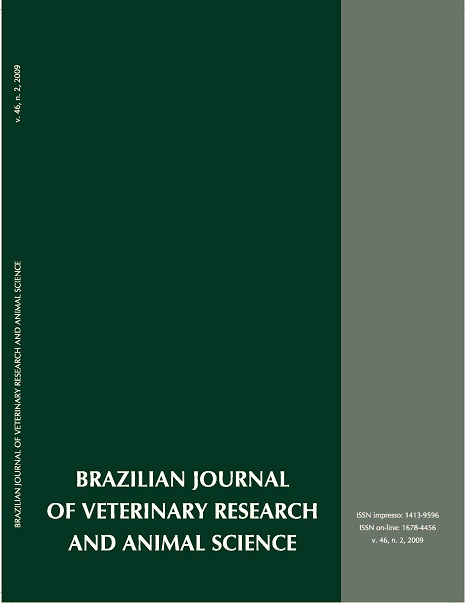Experimental infection of vampire bats Desmodus rotundus (E. Geoffroy) maintained in captivity by feeding defibrinated blood added with rabies virus
DOI:
https://doi.org/10.11606/issn.1678-4456.bjvras.2009.26754Keywords:
Rabies virus, Oral inoculation, Blood, ChiropteraAbstract
In vampire bats, food sharing behavior would contribute for the oral transmission of rabies virus among the roostmates. To test this hypothesis, 10 captive Desmodus rotundus bats were fed defibrinated swine blood containing mice brain suspension of PV-strain of rabies virus. Other 10 bats were fed blood mixed with a mice brain suspension of T-9/95 vampire-bat-field isolate of rabies virus. Another group of 10 bats was inoculated intramuscularly with a mice brain suspension of the T-9/95 isolate. Other 20 bats were maintained without treatment and fed defibrinated swine blood for 158 days. All animals found dead during the observation period or those sacrificed at the end of the experiment were necropsied and specimens such as the brain and non-nervous tissues were collected for rabies examination. Four bats inoculated intramuscularly developed clinical rabies, with signs lasting 1-2 days, and the survival periods ranged from 11-14 days. The initial rabies diagnosis was based on direct fluorescent antibody (dFA) and mouse inoculation test (MIT) performed only on brain specimens, and subsequently, brains and the non-nervous materials were further reexamined by means of dFA, MIT and heminested-polymerase chain reaction (ht-PCR) technique. The intake of the PV-strain caused rabies in 2 bats, with survival period of 25 and 32 days, while the three bats ingesting the T-9/95 isolate presented periods of 26-31 days. Although discrepant results were found among the diagnostic tests, viruses have disseminated to the central nervous system and other organs, as seen in bats inoculated intramuscularly.Downloads
Download data is not yet available.
Downloads
Published
2009-04-01
Issue
Section
UNDEFINIED
License
The journal content is authorized under the Creative Commons BY-NC-SA license (summary of the license: https://
How to Cite
1.
Souza MCAM, Nassar AF de C, Cortez A, Sakai T, Itou T, Cunha EMS, et al. Experimental infection of vampire bats Desmodus rotundus (E. Geoffroy) maintained in captivity by feeding defibrinated blood added with rabies virus. Braz. J. Vet. Res. Anim. Sci. [Internet]. 2009 Apr. 1 [cited 2025 Dec. 31];46(2):92-100. Available from: https://revistas.usp.br/bjvras/article/view/26754





